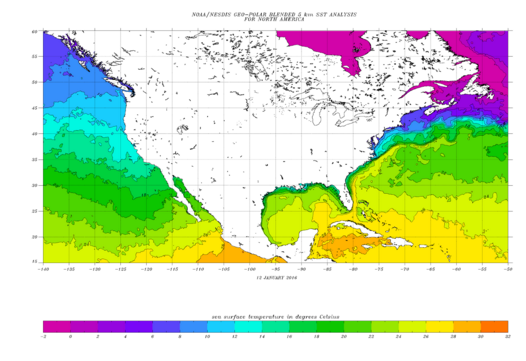Niño and global weirding: Discovering the truth about this “hot” topic

Intro
This winter has been categorized by near-balmy weather systems and little to no snowfall. These are characteristics that normally make-up a Connecticut spring — not winter.
The reason for this dramatic change is the El Nino Southern Oscillation or El Nino for short. El Nino is not a new phenomenon. It had a profound effect on weather patterns during the late 1990s and, recently, was predicted by the National Oceanic and Atmospheric Administration (NOAA) as having a 95 percent chance of affecting weather throughout the winter.
What is it?
El Nino is a natural yet irregular cycle that occurs every two-to-seven years. According to Gary Lessor, assistant to the director of Meteorological Studies and Weather Center at Western Connecticut State University, El Nino is characterized by “unusually warm ocean temperatures in the Equatorial Pacific.”
Scott Pecoriello ’15, who founded WeatherOptics, mentioned that the more severely the temperature of the water changes, the stronger the El Nino is. Currently, the world is experiencing a “strong” El Nino.
The Beginning:
The warming begins when winds reverse over the Pacific, bringing balmy Indonesian weather systems to the eastern Pacific.
El Nino Itself:
As this occurs, over two-thirds of the tropical Pacific warms to above-average temperatures, while the Atlantic becomes abnormally cold, altering weather systems across the United States and the world in nearly unpredictable ways.
The Effect:
The extra heat that gathers over the Pacific as a result of this warming leads to more rising air than normal. This extra heat affects the global atmospheric circulation.
According to Lessor, El Nino typically affects winter weather patterns by “keeping the polar jet stream further north than usual and at the same time providing an active subtropical jet stream with high levels of moisture across the southern states.”
What is causing it?
El Nino, although a seemingly straightforward issue, has prompted an incredible amount of debate within the scientific community regarding its exact effects and how many recent weather changes can be attributed to it.
“I basically attribute [the weather changes] to climate change,” Annemieke Mathissen ’16 said over coffee at the Westport Library.
Claire Meehan ’17 interrupted at this point, disagreeing and attributing these changes to El Niño, although she was unable to say exactly what the El Niño effect was.
In reality, perhaps unwittingly, both Meehan and Mathissen have voiced opposite opinions in a wider debate encompassing meteorologists and several members of the scientific community regarding exactly how many recent weather changes can be linked to El Niño.
It has been widely popularized by the media that El Nino is the central reason for California storms and the warming of the Northeast.
However, according to a “Scientific American” interview with Emily Becker, a research scientist and climatologist, those who link the balmy weather conditions in New England to El Nino are ignoring the “polar vortex,” which monopolized all weather related discussion last year.
The vortex, according to Becker, by keeping cold air in the high Arctic, has contributed to the weather conditions Connecticut is now experiencing.
Pecoriello echoed this opinion, mentioning the potential the Pacific Decadal Oscillation has to overpower the effects of El Nino later this year.
However, study recently published in the “Journal of Geophysical” research veers in the opposite direction of Becker, claiming that not only the recent weather variations but also the overall warming trend experienced in the last few years can be linked to El Nino. In other words, climate change can be attributed entirely to the El Nino effect.
Since this study’s publication it has been widely condemned by many. A study published in “Nature Climate Change,” in fact, claimed that climate change has actually had a direct effect on El Nino, causing the frequency and intensity of the El Nino effect to increase.
According to Pecoriello, however, the connection between El Nino and the warming of the earth is not necessarily direct.
“It’s likely that the El Nino effect is only felt around the world in relativity to surrounding ocean temperatures,” Pecoriello said. “In other words, if the earth warms as a whole, the number of El Nino’s shouldn’t drastically increase or decrease.”
Looking forward, Connecticut can expect an abnormally hot summer with a few wet weeks in May and June according to Lessor.
In terms of the rest of the winter, Pecoriello said more cold and higher rates of snowfall are expected.
Unknown effects of El Nino
- El Nino might double the risk of Civil War in tropical climates. This is largely because El Nino causes droughts, forcing food shortages and heightening tensions already in place.
- It is linked to certain disease outbreaks and even the creation of new pathogens.
- It might raise sea levels from Washington to California by eight inches. If this effect pans out it will affect over $40 billion of property.
The mass deaths of both dolphins and birds, mostly pelicans, near Peru and other parts of South America may also be linked to the El Nino effect.

It may have been a visceral feeling that instigated Claire Dinshaw ’17 to apply for a sports editor position her sophomore year, however, she refers...














































